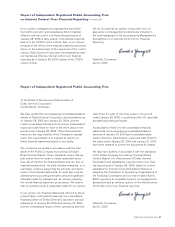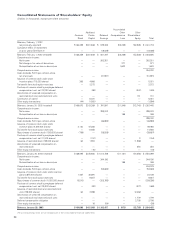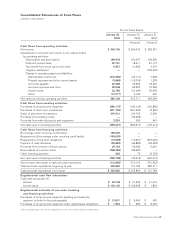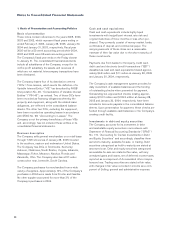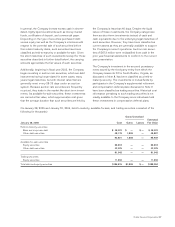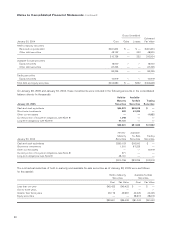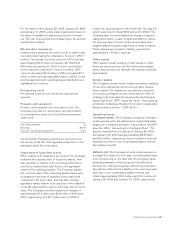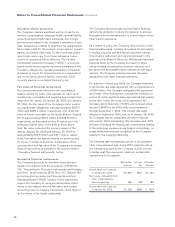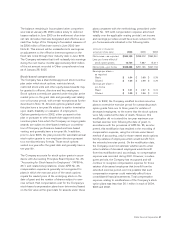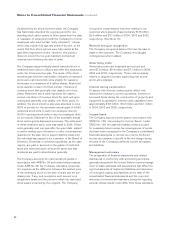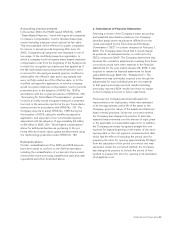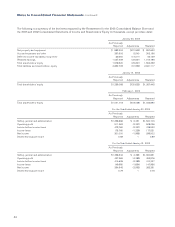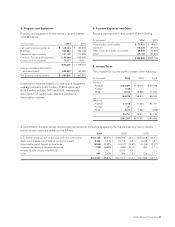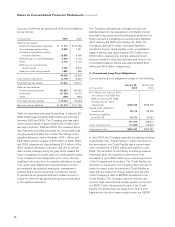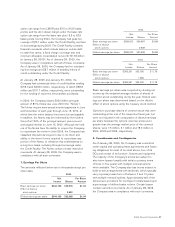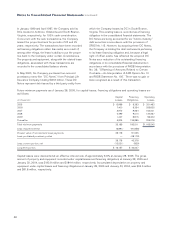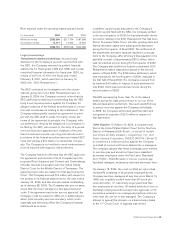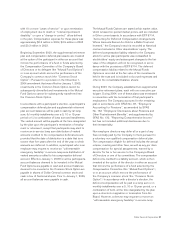Dollar General 2004 Annual Report Download - page 43
Download and view the complete annual report
Please find page 43 of the 2004 Dollar General annual report below. You can navigate through the pages in the report by either clicking on the pages listed below, or by using the keyword search tool below to find specific information within the annual report.
Dollar General Corporation 41
The balance remaining in Accumulated other comprehen-
sive loss at January 28, 2005 relates solely to deferred
losses realized in June 2000 on the settlement of an inter-
est rate derivative that was designated and effective as a
cash flow hedge of the Company’s forecasted issuance of
its $200 million of fixed rate notes in June 2000 (see
Note 6). This amount will be reclassified into earnings as
an adjustment to the effective interest expense on the
fixed rate notes through their maturity date in June 2010.
The Company estimates that it will reclassify into earnings
during the next twelve months approximately $0.2 million
of the net amount recorded in Other comprehensive loss
as of January 28, 2005.
Stock-based compensation
The Company has a shareholder-approved stock incentive
plan under which stock options, restricted stock,
restricted stock units and other equity-based awards may
be granted to officers, directors and key employees.
Stock options currently are granted under this plan at the
market price on the grant date and generally vest ratably
over a four-year period, with certain exceptions as further
described in Note 10. All stock options granted under
this plan have a ten-year life subject to earlier termination
upon death, disability or cessation of employment.
Options granted prior to 2002, either pursuant to this
plan or pursuant to other shareholder-approved stock
incentive plans from which the Company no longer grants
awards, are subject to time-based vesting or a combina-
tion of Company performance-based and time-based
vesting, and generally have a ten-year life. In addition,
prior to June 2003, the plan provided for automatic annual
stock option grants to non-employee directors pursuant
to a non-discretionary formula. Those stock options
vested one year after the grant date and generally have a
ten-year life.
The Company accounts for stock option grants in accor-
dance with Accounting Principles Board Opinion No. 25,
“Accounting for Stock Issued to Employees” (“APB No.
25”), and related interpretations. Under APB No. 25,
compensation expense is generally not recognized for
plans in which the exercise price of the stock options
equals the market price of the underlying stock on the
date of grant and the number of shares subject to exer-
cise is fixed. Had compensation cost for the Company’s
stock-based compensation plans been determined based
on the fair value at the grant date for awards under these
plans consistent with the methodology prescribed under
SFAS No. 123 (with compensation expense amortized
ratably over the applicable vesting periods), net income
and earnings per share would have been reduced to the
pro forma amounts indicated in the following table.
(Amounts in thousands,
except per share data) 2004 2003 2002
Net income—as reported $344,190 $299,002 $262,351
Less pro forma effect of
stock option grants 10,724 7,867 15,217
Net income—pro forma $333,466 $291,135 $247,134
Earnings per share—
as reported
Basic $ 1.04 $ 0.89 $ 0.79
Diluted $ 1.04 $ 0.89 $ 0.78
Earnings per share—
pro forma
Basic $ 1.01 $ 0.87 $ 0.74
Diluted $ 1.00 $ 0.86 $ 0.74
Prior to 2002, the Company modified its stock incentive
plans to extend the exercise period for outstanding stock
option grants from one to three years for estates of
deceased employees, to the extent that the stock options
were fully vested at the date of death. However, this
modification did not extend the ten-year maximum con-
tractual exercise term following the date of grant. In
accordance with the provisions of APB No. 25, as inter-
preted, this modification has resulted in the recording of
compensation expense, using the intrinsic-value based
method of accounting, only for those vested stock options
held by estates of employees which would benefit from
the extended exercise period. On the modification date,
the Company could not estimate whether and to what
extent estates of deceased employees would benefit
from this modification and, accordingly, no compensation
expense was recorded during 2001. However, in subse-
quent periods, the Company has recognized and will
continue to recognize compensation expense for those
estates of deceased employees that benefit from the
extended exercise period, and it is possible that such
compensation expense could materially affect future
consolidated financial statements. Total compensation
expense relating to modifications of the Company’s stock
option plans was less than $0.1 million in each of 2004,
2003 and 2002.


